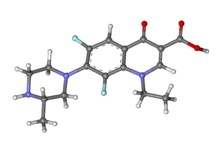Lomefloxacin
Appearance
 | |
 | |
| Clinical data | |
|---|---|
| Trade names | Maxaquin |
| AHFS/Drugs.com | Consumer Drug Information |
| MedlinePlus | a600002 |
| ATC code | |
| Pharmacokinetic data | |
| Protein binding | 10% |
| Elimination half-life | 8 hours[1] |
| Identifiers | |
| |
JSmol) | |
| Melting point | 239 to 240.5 °C (462.2 to 464.9 °F) |
| |
| |
| (verify) | |
Lomefloxacin hydrochloride (sold under the following brand names in English-speaking countries Maxaquin, Okacyn, Uniquin) is a
fluoroquinolone antibiotic used to treat bacterial infections including bronchitis and urinary tract infections. It is also used to prevent urinary tract infections prior to surgery. Lomefloxacin is associated with phototoxicity and central nervous system adverse effects.[2]
In October 2008, the
chelate
with itself. The chelate is formed between the 2-carbonyl group of two separate lomefloxacin molecules."
It was patented in 1983 and approved for medical use in 1989.[3]
References
- PMID 28431777.
Lomefloxacin elimination half-life is about 7–8 h and is prolonged in patients with renal impairment.
- S2CID 21890070.
- ISBN 9783527607495.
